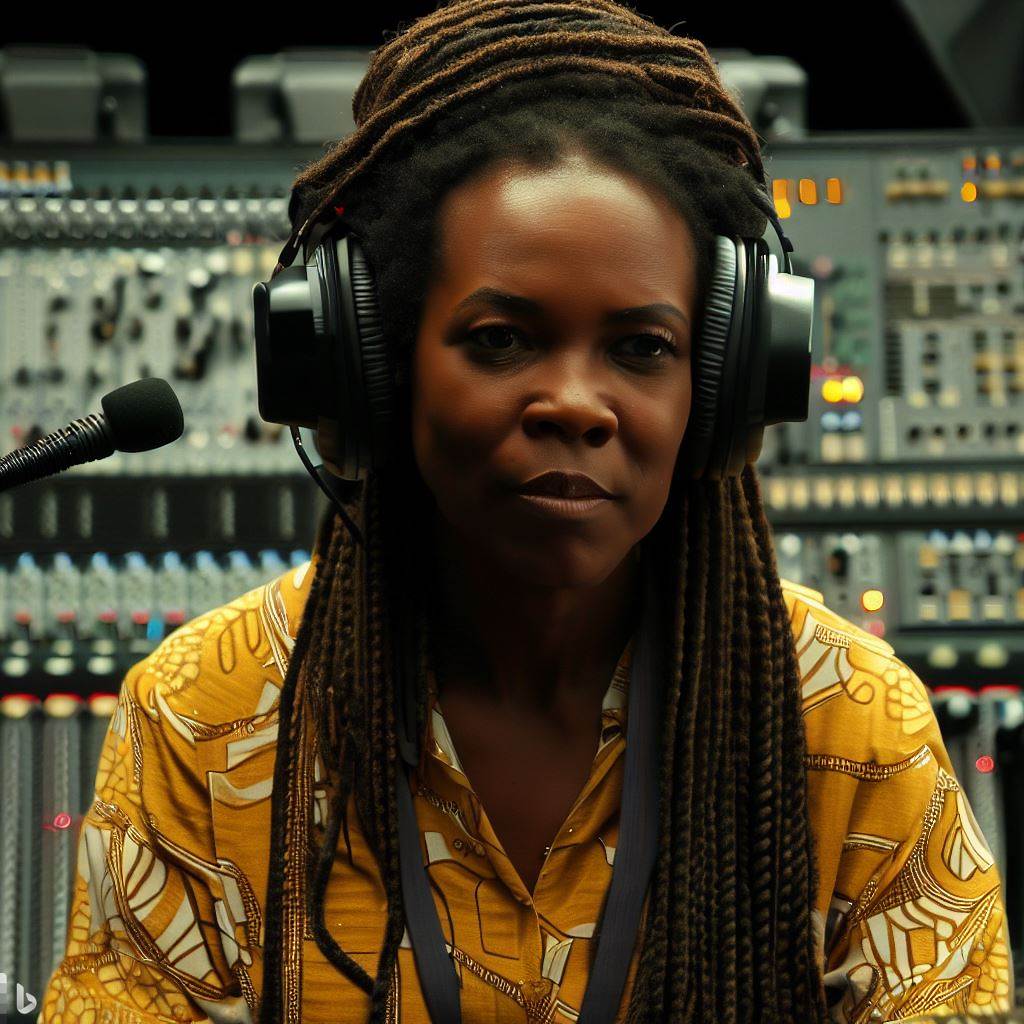Nollywood Sound Design: The Rise of Foley Artistry in Nigeria
Last Updated on January 26, 2024
Introduction
Nollywood is a term used to describe Nigeria’s vibrant film industry, known for its prodigious output of movies. It has grown to become the second-largest film industry in the world, after Bollywood.
With its unique storytelling style and cultural relevance, Nollywood has gained significant recognition in the global film industry.
Sound design plays a crucial role in enhancing the cinematic experience and captivating the audience.
It encompasses all the audio elements in a film, including dialogue, music, and sound effects, creating an immersive environment for viewers.
Effective sound design can heighten emotions, build tension, and convey meaning, amplifying the impact of the story.
In recent years, Foley artistry has emerged as a prominent aspect of sound design in Nollywood.
Foley artists reproduce and create sounds through various techniques, using objects and props, to enhance the realism and detail of a film’s audio.
This art form has gained popularity among Nigerian filmmakers who recognize its potential to elevate their storytelling.
The rise of Foley artistry in Nigeria’s film industry can be attributed to several factors.
Firstly, it allows filmmakers to cater to the cultural nuances and specificities of Nigerian audiences by creating authentic sounds.
Foley artistry also offers a cost-effective alternative to relying solely on pre-recorded sound effects, giving filmmakers more creative control over their projects.
Additionally, the growing accessibility of technology and resources has facilitated the development of Foley artistry in Nigeria, making it an integral part of sound design.
In the end, Nollywood’s significance in the global film industry cannot be understated, and sound design plays a crucial role in engaging the audience.
The rise of Foley artistry in Nigeria’s film industry showcases its growing popularity and importance in creating authentic and immersive audio experiences.
Understanding Nollywood Sound Design
Sound design and its role in enhancing storytelling
Sound design refers to the process of creating and manipulating audio elements to enhance the overall experience of a film or any other visual medium.
It involves the careful selection and integration of various sound elements, such as dialogue, music, ambient sounds, and special effects, to create a realistic and immersive audio environment that supports and complements the storytelling.
Sound design plays a crucial role in enhancing storytelling by adding layers of emotion, atmosphere, and significance to the visual narrative.
It helps to create a sense of realism, establish the mood and tone of a scene, and guide the audience’s attention.
Sound can evoke emotions, convey information, and even provide a deeper understanding of the characters and their surroundings.
The unique challenges faced by Nollywood filmmakers in terms of sound quality
Nollywood, the Nigerian film industry, faces several unique challenges when it comes to achieving high-quality sound in its productions.
One of the main challenges is the low budgets that limit the resources available for sound recording and post-production.
Filmmakers often have to work with limited equipment and rely on affordable solutions, which can compromise the sound quality.
Another challenge is the lack of proper sound recording and mixing facilities. Many Nollywood productions take place in outdoor locations or small indoor spaces that are not acoustically treated.
This leads to issues such as background noise, echo, and inconsistent sound quality, which can distract the audience and undermine the overall viewing experience.
The rapid production schedule of Nollywood films, with tight deadlines and quick turnaround times, also poses a challenge for achieving optimal sound quality.
There is often limited time available for thorough sound recording, editing, and mixing, leading to rushed and subpar results.
The previous reliance on stock sound libraries and the limitations it brought
In the past, Nollywood filmmakers heavily relied on stock sound libraries to source the necessary audio elements for their productions.
These libraries provided pre-recorded sound effects, music samples, and even dialogue snippets that could be easily incorporated into the films.
While this approach offered convenience and saved time, it had significant limitations.
Firstly, the stock sound libraries often contained generic and overused sound effects that lacked originality and failed to represent the unique characteristics of Nigerian culture and storytelling.
This resulted in a lack of authenticity and originality in Nollywood films’ audio aspects.
Additionally, the stock sound libraries lacked variety and specificity, making it challenging for filmmakers to find the perfect sound to match the visual narrative.
They had to settle for close alternatives that might not fully capture the intended emotion or ambiance, resulting in a compromise in the overall impact of the sound design.
Moreover, the use of stock sound libraries limited the artistic freedom and creative expression of Nollywood sound designers.
They were confined to the available options and couldn’t fully explore their creativity or tailor the sound design to the specific needs of their films.
Furthermore, relying on stock sound libraries created a sense of predictability and repetitiveness in Nollywood films’ audio, as certain sound effects or music samples became recurrent across different productions.
This diminished the element of surprise and innovation in the sound design.
Overall, the previous reliance on stock sound libraries hampered the development of a unique and authentic sound identity for Nollywood and constrained the potential of sound design as a storytelling tool.
Read: Animation Education: Top Courses in Nigeria
The Emergence of Foley Artistry in Nigeria
In the early days of cinema, Foley artistry emerged as a revolutionary technique that brought sound effects to life.
This concept involves creating and recording everyday sounds to enhance the audio experience of a film. Originating in the 1920s, Foley artistry quickly became an integral part of the filmmaking process.
As the Nigerian film industry, famously known as Nollywood, began to flourish, the need for high-quality sound design became evident.
Foley artistry gradually gained recognition as filmmakers realized its potential to immerse audiences in their stories.
This technique allowed them to add depth and authenticity to their films, setting them apart from other regional film industries.
The Evolution of Foley Artistry in Nollywood
Over the years, several pioneers have played a fundamental role in introducing and developing Foley artistry in Nigeria’s film industry.
These individuals recognized the importance of sound effects and worked tirelessly to promote their inclusion in Nollywood productions.
- Emem Isong – As one of the early advocates of Foley sound in Nollywood, Emem Isong paved the way for sound design to become an essential aspect of Nigerian films.
She emphasized the need for authenticity and believed that Foley artistry was the key to achieving it. - Obi Emelonye – Emelonye is another pioneer who contributed significantly to the rise of Foley artistry in Nigeria.
His film “Last Flight to Abuja” showcased the power of sound effects in creating a gripping cinematic experience. This film became a turning point for sound design in Nollywood. - Kunle Afolayan – Afolayan’s film “The Figurine” marked a milestone in the incorporation of Foley artistry in Nigerian cinema.
He collaborated with renowned South African sound designer, Michael Botha, to create a captivating audio experience that heightened the emotional impact of the movie.
Thanks to the influence of these pioneers and the growing awareness of Foley artistry’s potential, the Nigerian film industry has witnessed a significant improvement in sound design.
Filmmakers now understand the value of investing in sound effects and the impact they can have on the overall quality of their productions.
The Benefits and Future of Foley Artistry in Nollywood
Foley artistry offers numerous benefits to Nollywood filmmakers. Firstly, it adds a layer of realism to the visual elements of a film, making scenes more believable and immersive.
Audiences can fully engage with the story and connect emotionally with the characters. Furthermore, Foley artistry allows filmmakers to overcome technical limitations during filming.
Certain sounds may not be captured adequately on set, but Foley artists can recreate them in post-production, ensuring that the film’s audio matches the visual integrity.
Moving forward, it is crucial for Nollywood to continue embracing Foley artistry and investing in sound design.
As the industry competes on a global scale, the quality of sound effects will play an essential role in elevating Nigerian films and attracting international recognition.
By recognizing the importance of Foley artistry, Nollywood can continue to grow and innovate, setting new standards for audiovisual storytelling.
In fact, Foley artistry has emerged as an integral part of Nollywood’s filmmaking process.
Through the dedication of early pioneers and a growing understanding of its benefits, sound design has gained recognition and importance within the industry.
Moving forward, the continued integration of Foley artistry will be crucial for the success and growth of the Nigerian film industry.
Read: Foley Artistry: A Hidden Profession Boosting Nigeria’s Film Success
Benefits of Foley Artistry in Nollywood Films
When it comes to the art of filmmaking, sound design plays a crucial role in creating an immersive and captivating viewing experience.
In recent years, Nollywood filmmakers have recognized the importance of foley artistry in enhancing their films.
Foley, the reproduction of everyday sounds added to a film during post-production, brings several benefits to Nollywood films and the audience’s overall enjoyment.
Positive Impact on the Overall Viewing Experience
- Foley artistry significantly contributes to the overall quality and realism of Nollywood films.
- The careful integration of foley sounds can elevate the storytelling and engage the audience at a deeper level.
- It allows the viewers to connect with the characters and scenes by adding a layer of authenticity.
- The enhanced audio experience created by foley artistry creates a more immersive and enjoyable viewing experience.
- Through the use of foley, Nollywood films can rival international productions in terms of sound design and production value.
Enhancing Realism and Immersive Environment
- Foley artistry plays a crucial role in making the on-screen actions and events feel more realistic.
- By adding carefully crafted sounds, foley artists can enhance the illusion of realism in Nollywood films.
- Footsteps, ambient noises, and object interactions are meticulously recreated, enhancing the believability of the scenes.
- The immersive environment created by foley allows the audience to be fully engrossed in the narrative.
- It helps in creating a seamless audio-visual experience where every element feels harmoniously integrated.
Emotional and Psychological Effects on the Audience
- Foley artistry has a profound impact on the emotional and psychological responses of the audience.
- The added sounds can intensify the suspense, drama, and tension in specific scenes.
- Through the use of foley, filmmakers can manipulate the emotions of the viewers, evoking fear, joy, or sadness.
- By immersing the audience in a sonic landscape, foley enhances the emotional connection with the characters.
- It helps in creating a multisensory experience where the audience can feel and empathize with the story.
In review, foley artistry has become an indispensable tool in the Nollywood filmmaking industry.
Its positive impact on the overall viewing experience, enhancement of realism, and creation of an immersive environment make it invaluable.
Furthermore, the emotional and psychological effects it has on the audience contribute to a more engaging and memorable film-watching experience.
As Nollywood continues to evolve, the importance of foley artistry will only grow, cementing its position as a vital component of successful Nigerian films.
Read: The Impact of Tech on Animation Direction in Nigeria

The Process and Techniques of Foley Artistry
When it comes to creating realistic sound effects for movies, Foley artists play a crucial role. These behind-the-scenes wizards use various tools and techniques to bring the world of the film to life.
In this section, we will delve into the fascinating world of Foley artistry, exploring the creative process, tools, equipment, and the importance of synchronization and attention to detail.
1. Exposing the Creative Process
The creative process of Foley artistry is a meticulous and artistic endeavor. Foley artists watch the scenes of a film and identify the sounds that need to be recreated.
They carefully analyze every detail, from the sound of footsteps to the rustling of clothes, in order to create a fully immersive audio experience.
Using their creativity and imagination, Foley artists devise innovative ways to recreate these sounds. They often use a combination of different objects to achieve the desired effect.
For example, they may use coconut shells to mimic the sound of horse hooves or crumple paper to recreate the sound of fire.
Once they have a clear vision of the sounds they want to create, Foley artists start recording.
They typically work in a Foley studio, which is equipped with various props and surfaces that help produce different sounds.
The artists carefully coordinate their movements with the actions on screen to ensure perfect synchronization.
2. Tools and Equipment
Foley artists rely on a wide range of tools and equipment to create realistic sound effects. Here are some of the most commonly used:
- Microphones: Foley artists use high-quality microphones to capture sounds with precision.
- Props: They utilize numerous props, such as shoes, fabrics, or kitchen utensils, to recreate different types of sounds.
- Surfaces: Foley studios have surfaces like wood, gravel, or water tanks that allow artists to mimic various environmental sounds.
- Footsteps: Foley pits, made of different materials like sand or gravel, are used to create the sound of footsteps.
These tools and equipment, along with the artists’ creativity, ensure that the sounds created are incredibly realistic and enhance the overall cinematic experience.
3. Importance of Synchronization and Attention to Detail
In the world of Foley artistry, synchronization and attention to detail are of utmost importance.
Foley artists meticulously match the sounds they create to the actions on screen, ensuring that each movement is accompanied by the correct sound.
They pay close attention to the rhythm, pace, and timing of the scene to ensure perfect synchronization.
This level of detail brings authenticity to the film’s audio, making the audience feel fully immersed in the story.
Foley artists also understand the importance of capturing the intricacies of everyday sounds. They are keen observers of real-life situations and use their expertise to recreate these sounds accurately.
For example, the subtle noise of a character handling a cup or the sound of a door closing can greatly enhance the audience’s connection to the story.
In essence, Foley artistry is a creative and intricate process that involves using various tools and techniques to recreate realistic sound effects.
Foley artists play a vital role in enriching the cinematic experience by paying attention to every detail and ensuring perfect synchronization.
Their work may often go unnoticed, but it is an essential element in creating captivating films.
Read: Prominent Nigerian Films and the Foley Artistry Behind Them
Delve into the Subject: Digital Journalism Trends Shaping Nigeria’s Media
Foley Challenges and Innovations in Nollywood
In this section, we will delve into the unique obstacles faced by Foley artists in Nigeria, the scarcity of reliable sound studios and equipment, and the recent technological advancements and innovations in Nollywood’s Foley industry.
Unique Obstacles Faced by Foley Artists in Nigeria
- Limited resources and funding hinder the creativity and potential of Foley artists.
- Frequent power outages disrupt the workflow and make it challenging to meet deadlines.
- Lack of formal training opportunities restricts the growth and skill development of Foley artists.
- The cultural perception of sound design as a secondary profession affects recognition and respect for Foley artists.
Scarcity of Reliable Sound Studios and Equipment
- Nigeria’s expanding film industry faces a shortage of sound studios equipped for Foley work.
- Inadequate soundproofing leads to unwanted background noise interference during recordings.
In a nutshell, Foley artists in Nigeria face unique challenges due to limited resources, unreliable studios, and societal perceptions.
However, recent technological advancements have brought about exciting innovations in Nollywood’s Foley industry, empowering artists with more creative possibilities and efficient workflows.
Read: Nigeria’s Entertainment Industry: A Goldmine for Creative Professionals
Learn More: Becoming an Agent: Pathways in Nigeria’s Art Scene
Foley Artistry: Shaping the Future of Nollywood Sound Design
In recent years, Nollywood, the Nigerian film industry, has gained significant recognition globally for its unique storytelling and vibrant cinematography.
However, one aspect that is often overlooked but has played a crucial role in enhancing the cinematic experience is Foley artistry.
The rise of Foley in Nollywood films has pushed the boundaries of sound design and has the potential to shape the future of the industry.
Increasing Recognition and Global Impact
Foley artistry, the practice of creating and enhancing sound effects in post-production, has been steadily gaining recognition in Nollywood.
Previously, Nollywood films relied heavily on stock sound libraries, resulting in a lack of authenticity and immersion for viewers.
However, with the introduction of Foley, Nigerian filmmakers have been able to elevate the sound design and bring a sense of realism to their films.
The impact of Foley artistry on Nollywood’s global reputation cannot be understated.
International audiences have begun to appreciate and acknowledge the attention to detail that goes into creating sound effects that are specific to the Nigerian context.
This recognition has not only boosted the credibility of Nollywood as a film industry but has also helped to create a distinct identity for Nigerian cinema.
Pushing the Boundaries of Sound Design
The rise of Foley in Nollywood has pushed the boundaries of sound design in Nigerian films.
Foley artists have been able to experiment with different techniques and equipment to create unique sounds that enhance the emotional impact of a scene.
Whether it’s the sound of footsteps on a dusty street or the rustling of leaves in a quiet forest, Foley has allowed filmmakers to add a layer of depth and authenticity to their storytelling.
Furthermore, Foley artistry has enabled Nollywood filmmakers to overcome technical limitations.
With limited access to high-end recording equipment, Foley artists have often had to rely on creative solutions.
This has led to the development of resourceful methods to produce sound effects using everyday objects, showcasing the ingenuity and innovation within the Nigerian film industry.
Potential Growth and Influence
Looking ahead, the potential growth and influence of Foley artistry in the future of Nollywood seem promising.
As the industry continues to expand and attract international attention, the demand for high-quality sound design will only increase.
Foley artists will play a vital role in meeting this demand by creating immersive soundscapes that enhance the storytelling experience.
Additionally, the rise of Foley has opened up new career opportunities for aspiring sound designers in Nigeria.
With the increasing recognition and appreciation for their work, Foley artists are now essential members of film production teams.
This acknowledgment has not only elevated the status of Foley artistry but has also provided a platform for talent development within the Nigerian film industry.
Basically, Foley artistry is shaping the future of Nollywood sound design by contributing to the industry’s global reputation, pushing the boundaries of sound design, and driving potential growth and influence.
As the Nigerian film industry continues to evolve, the role of Foley in enhancing the cinematic experience cannot be underestimated.
Nollywood’s embrace of Foley artistry highlights the industry’s commitment to delivering high-quality and immersive storytelling.
Conclusion
The rise of Foley artistry in Nigeria has brought significant advancements to Nollywood’s sound design.
Foley artists have played a crucial role in enhancing the realism and immersive experience of films by creating and adding sound effects through their creative techniques.
This has greatly contributed to the evolution of sound in Nigerian films. It is essential for readers to appreciate the importance of sound in film and acknowledge the craftsmanship of Foley artists.
By exploring the works of Nigerian Foley artists, audiences can gain a deeper understanding of the intricate process of sound design and its impact on the overall cinematic experience.
Furthermore, Foley artistry has had a positive impact on Nigeria’s film industry. It has elevated the quality of sound in Nollywood films, making them more engaging and professional.
This has helped to attract both local and international viewers, thereby increasing the industry’s global recognition and opening doors for collaboration with filmmakers from around the world.
Foley artistry is a critical aspect of Nollywood’s sound design and has revolutionized the way sound is perceived in Nigerian films.
As audiences, it is important to value and appreciate the immense efforts of Foley artists and explore their works. By doing so, we can contribute to the continued growth and success of Nigeria’s film industry.


